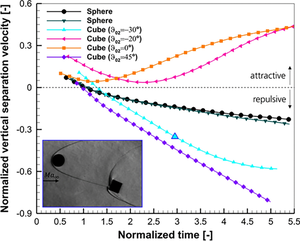Aerodynamic interactions of blunt bodies free-flying in hypersonic flow
Abstract
This paper takes a new look at how the aerodynamic interactions of multiple bodies in high-speed flow affect their motion behaviors. The influence of the body shape and orientation on aerodynamic and stability behavior in the case of shock–shock and wake–shock interactions is the focus of this publication. Experiments were performed in the hypersonic wind tunnel H2K at the German Aerospace Center (DLR) in Cologne. Free-flight tests with tandem arrangements of spheres and cubes were performed with a synchronized dropping of both objects at various initial conditions of relative streamwise and vertical distance as well as pitch angle. A high-speed stereo-tracking captured the model motions during free-flight, and high-speed schlieren videography provided documentation of the flow topology. Based on the measured 6-degrees-of-freedom (6DoF) motion data, aerodynamic coefficients were determined. As a result, the final lateral velocity of trailing cubes is found to be many times greater than that of spheres regarding shock-wave surfing. For rotating cubes, the results showed that stable shock-wave surfing can become possible over an increasingly wide range of initial positions. This study has identified that the trailing drag coefficient of two axially aligned objects varies strongly with their relative streamwise distance. Furthermore, it was shown that the wake is a region of stability for downstream objects.
Graphical abstract


 求助内容:
求助内容: 应助结果提醒方式:
应助结果提醒方式:


